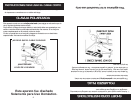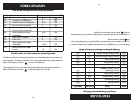
OIL LEVEL AND MAINTENANCE
Oil Selection:
1. We recommend the following oils for healthier deep-frying: corn, safflower,
soybean, or extra light olive oil. These oils are cholesterol free and low in
saturated fat.
2. We do not recommend frying with animal fats as they are more prone to
deteriorate under high heat. Heavily flavored oils such as extra virgin olive oil
should also be avoided.
3. We do not recommend mixing old and new oil together as this taints the new oil.
4. The number of times that the frying oil can be reused depends on the food that
is fried in it. For example, when foods that leave a residual flavor (such as fish)
are fried frequently, the oil will need to be replaced more often.
Note: When reusing oil, it is recommended that you strain the oil to remove food
particles. Use a mesh strainer over a bowl to separate food particles from the
oil.* For best results, you can line the mesh strainer with two layers of
cheesecloth. Once the oil is strained, place in a container that can be sealed
tightly and place in the refrigerator.
* ONLY AFTER THE OIL HAS COMPLETELY COOLED
It is important to replace the oil if you notice any of the following:
¾ An unpleasant odor to the oil
¾ Excessive smoking when heating the oil.
¾ Oil is dark in color.
¾ Oil has been stored for a long period of time.
Note: We do no recommend frying with animal fats or shortening. Using solid fat
or shortening to fry may cause your deep fryer to overheat. Also, it solidifies as it
cools, which makes it difficult to remove the submerged heating element and fryer
control from the oil tank.
7
NIVEL DE ACEITE Y MANTENIMIENTO
7
Selección del aceite:
1. Recomendamos los siguientes aceites para freír de una manera más sana:
maíz, cártamo, soya o de olivo extra ligero. Estos aceites son libres de
colesterol y bajos en grasa saturada.
2. No recomendamos freír con grasas animales porque son más propensas a
deteriorarse bajo calor alto. Los aceites con mucho sabor, como el aceite de
olivo extra virgen, se deben evitar.
3. Se recomienda no mezclar aceite nuevo con aceite viejo, ya que el aceite
nuevo se echará a perder más rápidamente.
4. El número de veces que se puede volver a usar el aceite para freír depende
del alimento que se fría en él. Por ejemplo, cuando los alimentos que dejan un
sabor residual (como el pescado) se fríen frecuentemente, se necesitará
reemplazar el aceite con más frecuencia.
Nota: Cuando vuelva a usar el aceite, se recomienda que cuele el aceite para
retirarle las partículas de alimentos. Use un colador de malla sobre un tazón
para separar las partículas de alimento del aceite. * Para mejores resultados,
usted puede forrar el colador de malla con dos capas de tela tipo manta de
cielo. Una vez que el aceite esté colado, colóquelo en un recipiente que se
pueda sellar de manera hermética y póngalo en el refrigerador.
* SÓLO DESPUÉS DE QUE EL ACEITE SE HA ENFRIADO POR COMPLETO
Es importante reemplazar el aceite si nota cualquiera de lo siguiente:
¾ Un olor desagradable en el aceite
¾ Humo excesivo cuando se calienta el aceite
¾ El aceite tiene un color oscuro
¾ El aceite se ha almacenado durante un periodo largo
Precaución: Usar grasa sólida o manteca para freír puede causar que su freidora
se caliente. Además de que se solidifica cuando se enfría, lo que dificulta
retirar la resistencia sumergida y el control de la freidora del tanque de aceite.


















